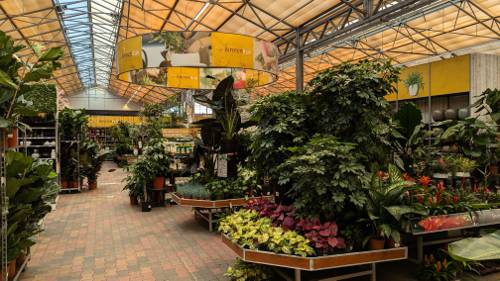
FAQ About Indoor Plant Nutrient Dynamics

What are essential nutrients for indoor plants?
Essential nutrients for indoor plants include macronutrients and micronutrients. The primary macronutrients are nitrogen (N), phosphorus (P), and potassium (K), which are vital for growth, flowering, and overall plant health. Secondary macronutrients include calcium (Ca), magnesium (Mg), and sulfur (S). Micronutrients, needed in smaller amounts, include iron (Fe), manganese (Mn), zinc (Zn), copper (Cu), molybdenum (Mo), boron (B), and chlorine (Cl). All these nutrients play specific roles in various physiological processes within the plant.

How do indoor plant nutrient dynamics differ from outdoor plants?
Indoor plant nutrient dynamics differ from outdoor plants primarily due to the controlled environment. Indoor plants often rely on potting soil which may have limited nutrient content and is typically not replenished naturally. Outdoor plants can access nutrients from a larger volume of soil and natural processes like rain and soil microbiota activity. Therefore, indoor plants may need regular supplementation through fertilizers to maintain nutrient balance and ensure healthy growth.

Why is nitrogen important for indoor plants?
Nitrogen is crucial for indoor plants because it is a major component of chlorophyll, which is necessary for photosynthesis – the process by which plants convert light energy into chemical energy. It also plays a vital role in amino acids, the building blocks of proteins, and nucleic acids. Adequate nitrogen ensures vigorous growth, strong stems, and healthy foliage.

How can I tell if my indoor plant is nutrient-deficient?
Signs of nutrient deficiency in indoor plants can include yellowing leaves, stunted growth, poor flowering, browning leaf edges, and leaf drop. Different nutrients cause different symptoms; for example, nitrogen deficiency often causes older leaves to yellow, while phosphorus deficiency leads to purpling of leaves and stunted growth. Regular monitoring and soil testing can help diagnose specific deficiencies.

How often should I fertilize my indoor plants?
The frequency of fertilizing indoor plants depends on the type of plant, the growing conditions, and the time of year. Generally, during the active growing season (spring and summer), plants may need fertilization every 2-4 weeks. In the dormant months (fall and winter), reduce fertilization as growth slows or stops completely. Always follow the specific needs of your particular plants and the instructions on the fertilizer package.

What is the role of potassium in plant health?
Potassium is vital for maintaining plant health as it plays a key role in regulating water movement within plant tissues, activating enzymes involved in photosynthesis, and aiding in the synthesis of proteins and starches. It also helps strengthen cell walls and provides disease resistance. Adequate potassium ensures that plants have strong stems, support blooming, and develop resilience against stress conditions.

Can indoor plants get too many nutrients?
Yes, indoor plants can suffer from nutrient toxicity if over-fertilized. This condition, known as nutrient burn, can manifest as browning leaf tips, wilting, or stunted growth and often affects young and more sensitive plants. It is crucial to follow recommended fertilizer applications and use products suited to the specific needs of your plants to prevent nutrient overload.

How does soil pH affect nutrient availability for indoor plants?
Soil pH can significantly affect the availability of nutrients to plants. Most indoor plants prefer a slightly acidic to neutral pH (5.5 to 7.0). At this range, essential nutrients are more soluble and accessible. If the pH is too high (alkaline) or too low (acidic), certain nutrients become less available, leading to deficiency symptoms, even if the nutrients are present in the soil.

What are some common signs of over-fertilization in indoor plants?
Common signs of over-fertilization include leaf burn (browning of leaf edges and tips), slow growth despite adequate water and light, leaf drop, crusty build-up on the soil surface or pots, and wilting. If you suspect over-fertilization, flush the soil with water to leach out excess nutrients and pause further fertilization until the plant recovers.

Why is phosphorus important for indoor plants?
Phosphorus is important for indoor plants because it plays a key role in energy transfer within the plant through compounds such as ATP (adenosine triphosphate). It is also crucial for root development, flowering, and fruiting. Adequate phosphorus ensures that plants have strong root systems and produce abundant blooms and fruits.

What role does calcium play in indoor plants?
Calcium is essential for indoor plants as it helps build strong cell walls, which prevents cellular collapse and contributes to structural integrity. It also plays a role in nutrient absorption and enzymatic processes. Adequate calcium levels help prevent tip burn in leaves and support overall plant vitality.

How does magnesium deficiency affect indoor plants?
Magnesium deficiency in indoor plants can cause interveinal chlorosis, where the leaf tissue turns yellow while the veins remain green. This occurs because magnesium is a central component of the chlorophyll molecule, necessary for photosynthesis. A lack of magnesium impairs chlorophyll production, affecting the plant's ability to photosynthesize effectively.

What is the impact of indoor plant nutrient dynamic on plant diseases?
The nutrient dynamics within indoor plants can significantly impact their susceptibility to diseases. A balanced nutrient supply strengthens the plant's natural defenses, reducing the likelihood of disease outbreaks. On the other hand, an imbalance, whether from deficiency or excess of nutrients, can weaken plants and make them more susceptible to infections and infestations.

How can I adjust nutrient levels for my indoor plants?
To adjust nutrient levels for indoor plants, first, identify the specific deficiency or excess through observation and soil testing. Adjust the fertilizer type or concentration as needed. Use balanced fertilizers for general maintenance and specific supplements for addressing identifiable deficiencies. Dilute fertilizers properly and follow package instructions to avoid nutrient toxicity.

What is the role of micronutrients in indoor plant health?
Micronutrients, despite being required in smaller quantities compared to macronutrients, play crucial roles in various physiological and biochemical processes. They are involved in chlorophyll synthesis, enzyme function, and hormone production. Deficiencies in micronutrients can result in stunted growth, leaf discoloration, and poor plant resilience.

Can tap water affect the nutrient balance in indoor plants?
Yes, tap water can affect the nutrient balance in indoor plants. Hard water contains high levels of calcium and magnesium, which may alter soil pH and affect nutrient availability. Chlorine and fluorides in tap water may also accumulate and harm plants over time. Consider using filtered or distilled water to mitigate these effects, especially for sensitive plants.

What are ways to naturally improve nutrient availability for indoor plants?
Natural ways to improve nutrient availability for indoor plants include using organic fertilizers like compost, vermicompost, or manure, which release nutrients slowly and improve soil structure. You can also use mulch to retain moisture and nutrients. Regular repotting with fresh, nutrient-rich soil can also help ensure plants have adequate resources for growth.

How do nutrient deficiencies affect indoor plant growth and appearance?
Nutrient deficiencies can greatly impact indoor plant growth and appearance, manifesting as yellowing or discolored leaves, weak stems, reduced flowering, and poor root development. Each nutrient deficiency presents different symptoms; for example, nitrogen deficiency typically causes yellowing of older leaves, while iron deficiency leads to chlorosis in newer leaves. Addressing deficiencies promptly is key to maintaining plant health.

How can I use soil testing to optimize nutrient management for indoor plants?
Soil testing is a critical tool for optimizing nutrient management in indoor plants. It helps determine the current nutrient levels, pH balance, and organic matter content of the soil. This information guides the specific adjustment of fertilizers and soil amendments, ensuring plants receive the necessary nutrients without the risk of over-fertilization. Regular soil tests can also track changes and inform timely interventions.
